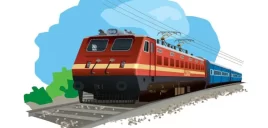Many locos can be used as bankers on ghat sections. Usually, goods locos are used for banking duties, although this is not a rigid rule. The leading loco on a ghat section can in general be any loco provided it has suitable braking systems, etc.
There are some ghat special powers — locomotives that are specially modified for duties on steep gradients. These are usually equipped with an ‘Auto-Emergency’ (‘AE’ or ‘AEB’) brake system, which is an electronically controlled system which monitors the speed of the loco and applies the brakes automatically if it exceeds 25km/h (or other speed limit appropriate for the section).
These powers are especially used on steep gradients where catch sidings may not be provided (e.g., Braganza ghat Castle Rock – Kulem; in contrast, CR’s Lonavala-Karjat section and SER’s Krandol-Kacheli section have catch sidings and systems like AEB are not usually used). The AEB system is normally kept switched off in normal sections, and switched on only in the ghat section; the keys for these are kept with the station masters so that the drivers do not have the ability to override the system. Gooty is the only shed currently [6/03] where locos with AEB are regularly homed. (However, at least one loco in the 14xxx series homed at Krishnarajapuram has been spotted with stencilled indications that it had AEB ith a 30km/h restriction. [9/06]) In the past there were many WDM-2/2A/2B locos with AEB but now they have been phased out, and the locos with AEB now are WDM-3A and WDG-3A units.
A further safety feature in the Castle Rock – Kulem section is the running of trains in the so-called corridor system, where multiple goods trains are run in the same direction on the ghat section at times when passenger trains are not run, to maximize goods throughput while not endangering passenger trains in case of runaways.
There are many mandatory brake halts provided on steep sections. At these locations, the train must come to a complete halt before proceeding. Delayed signals are usually provided, which automatically clear after a track circuit with a timer detects that the train has stopped for the requisite amount of time. Usually, there are automatic points provided at these locations as well; if the train does not stop for the required duration the points will not be set for the main line and the train will be diverted to a catch siding or trap. Sometimes the brake halt is operated manually: a staff person is stationed at the halt and works the points and pulls of the signal only after the train has come to a halt, and the driver has signed in a register maintained for the purpose.
Source – IFRCA.org
Disclaimer: The Information /News /Video provided in this Platform has been collected from different sources. We Believe that “Knowledge Is Power” and our aim is to create general awareness among people and make them powerful through easily accessible Information. NOTE: We do not take any responsibility of authenticity of Information/News/Videos.
This entry was posted in 2 Railway Employee, STUDY NEW, Railway Employee











